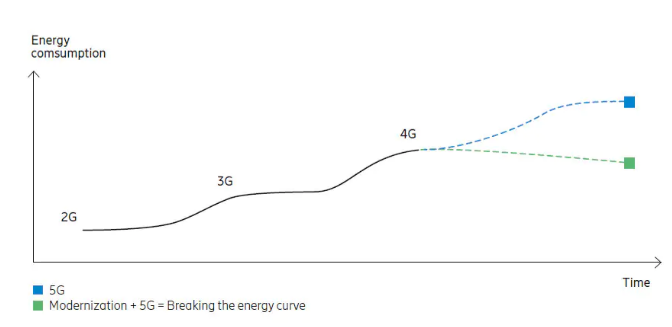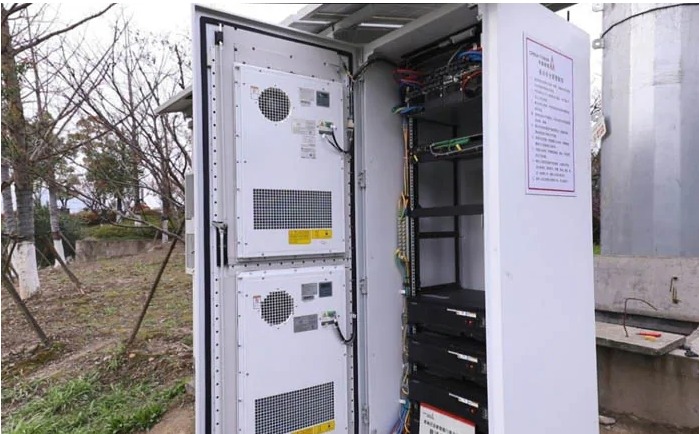Introduction
With 5G, the mobile industry finally has an opportunity to expand traffic while reducing energy consumption across the network. However, breaking this energy curve will take more than just technology. If 5G is deployed in the same way as previous generations to meet the increasing traffic demands, the energy consumption of mobile networks would increase dramatically. This is unsustainable in terms of cost as well as environmental impact.
According to GSMA’s report, the top 10 carriers in the world cost US$14 billion in electricity every year. Telecom operators are all devoting to energy conservation and emission reduction. 5G deployment will improve the industry’s energy efficiency since energy cost per bit on 5G is just one-tenth its level on 4G. However, the base stations are still energy-hungry at network-level, due to foreseeable tens of times traffic increase.
So the question now is Can we rollout 5G and reduce energy consumption?
The answer is yes. It is possible to break the energy curve. We see this as an opportunity to rethink how to build, operate and manage networks in a smarter and more strategic way. It is not only an option, it is an industry responsibility.

Breaking the energy curve, Source: Ericsson
5G Improves Energy Efficiency
Maximizing energy efficiency is one of the basic principles of 5G – there is a clear aim to keep the energy consumption of the mobile network at current levels, or even lower, despite increases in data traffic and the number of base stations.
5G has a number of solutions designed to achieve this target:
- 5G brings higher spectral efficiency by using beamforming antennas, higher spectrum utilization, and by using solutions to minimize interference. Average 5G spectral efficiency with a beamforming antenna can achieve 10 bps/Hz, five times higher than today’s typical 4G Long Term Evolution (LTE) network.
- 5G supports more capacity per cell using wider bandwidth: LTE bandwidth is up to 20 MHz, 5G mid-band is up to 100 MHz and 5G millimeter wave is up to 800 MHz. Wideband radios can carry much more data for similar power consumption.
- 5G enables power-saving features to minimize the power consumption of base stations.

5G solutions for higher energy efficiency, Source: Nokia
The Difference between 4G and 5G Power Consumption
5G networks include more efficient solutions to cut power consumption, with a particular focus on energy efficiency during low loading. LTE networks have shown that the average network level utilization is typically 10-25% over a 24 hour, 7-day period for the whole network. This low utilization is
caused by an unequal distribution of traffic, both over a 24-hour period and over the geographical area. Network loading is low at night and several cells are needed for coverage and will carry only low traffic volumes. All this means that base station resources are generally unused 75-90% of the time, even in highly loaded networks.
5G can make better use of power-saving techniques in the base station, offering great potential for improving energy efficiency across the network.
5G allows a hundred times more traffic to be carried, without increasing the total energy consumption of the network. Early deployments of 5G may lead to increases in energy efficiency if 5G is added on top of an existing network without modernizing the underlying 2G/3G/4G networks.
5G Technologies Minimize Power Consumption
5G has an incremental effect on existing mobile networks in several ways. The additional equipment required means that a 5G roll-out typically increases the energy consumption of existing sites.
To offset this effect, Nokia claims that Modernizing a typical legacy base station site to Single RAN can achieve an energy saving of up to 70% and reduce its annual CO2 emissions from more than 70 tonnes to just 17 tonnes. Furthermore, a Single RAN base station can reduce the Total Cost of
Ownership by up to 30% compared to a 5G or LTE overlay solution. Also, Liquid cooling can reduce the energy consumption of a typical base station site by up to 66%, compared to traditional air-cooling systems – the excess heat can even be sold as useable energy. All this can be achieved simply by shifting to a more efficient cooling system, with no adverse effects on network performance.
In the same direction, Ericsson proposes Swapping old radio equipment with 5G-ready Radio System equipment nationwide makes it possible for service providers to serve 5G use cases with a single software upgrade. And this could also save them up to 30 percent on overall energy consumption. Also, Ericsson proposed another good solution for minimizing the power consumption like deploying the most appropriate hardware in each part of the network where it is needed. MNOs can serve demand, such as through Massive MIMO in denser traffic sites, and avoid over-dimensioning equipment in areas where there is less traffic. Here they should instead be looking toward leaner, versatile 5G-ready radio systems.
Also, AI and advanced data analytics are already well integrated into many of today’s network management solutions. Yet, today, we see that they can increasingly offer more value in terms of reducing network energy consumption. Today, there are already solutions available on the market which allow service providers to operate their site infrastructure in a much more intelligent way. The savings offered by such solutions look likely to raise the pressure on service providers to modernize existing site infrastructure, in order to reap the gains right across the network.
Huawei’s Use Case for Energy Efficiency
The 5G Power solution jointly innovated by Huawei and China Tower is a comprehensive power supply solution for 5G sites. It focuses on improving the energy efficiency of the entire base station and addresses 5G construction and O&M issues. With its intelligent technologies, the power system becomes cognitive, which means the system can collaborate with the base station to achieve full-link high efficiency, saving power consumption by up to 18%. In this way, carbon emissions are reduced to the maximum extent.

Huawei 5G Power Solution
According to the statistics in Hangzhou, the 5G Power solution put forward by Huawei and China Tower can save 4130 kWh of power per site per year, cutting 1125 kilograms of carbon emissions. Besides, the solution improves 5G construction efficiency for its compact components and higher capacity can support legacy technology and 5G without adding new cabinets, reducing reconstruction cost of a site by more than 2,000 USD.
Conclusion
5G technology combined makes it possible to carry much more traffic in the mobile networks without increasing the overall network energy use. The important technology components include wideband transmission, beamforming techniques, lean carrier, and liquid-cooled base stations.
5G networks can also help reduce CO2 emissions by reducing travel through the greater use of remote working and by allowing more efficient use of the transportation systems and industrial processes.













